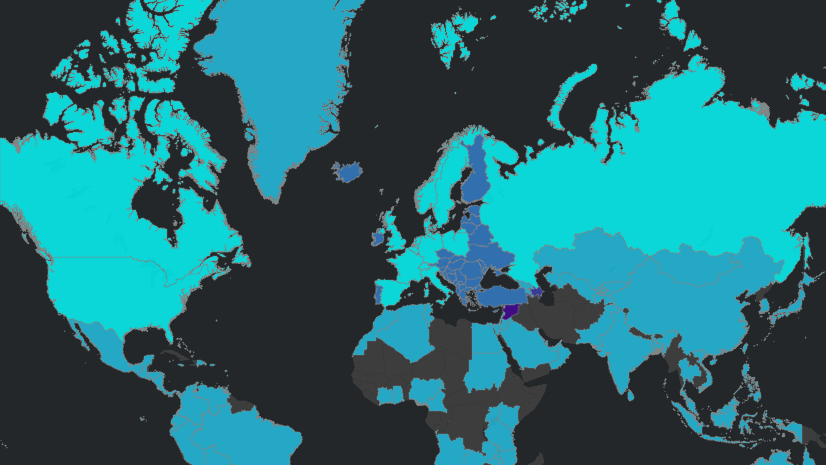Esri is pleased to announce details of the 2022 release of Esri U.S. Demographics! This is the first release to be based on new geography from the 2020 Census and incorporates many of the new data attributes from the same! Read on to learn more about Esri U.S. Demographics, see what’s coming in the 2022 release, and how to get started working with the data.
The following 2022 datasets are based on 2020 Census geography:
Esri Updated Demographics
Esri Updated Demographics represent the suite of annually updated U.S. demographic data that provide current-year and five-year forecasts of key demographic and socioeconomic characteristics. Esri Updated Demographics data are point estimates, representing July 1 of the current and forecast years.
What’s New in June: Data are updated to represent 2022 and 2027. Time Series data for population, household, and housing unit counts now start at 2020 instead of 2010.
American Community Survey (ACS) 2016-2020 Demographics
Esri provides the US Census Bureau’s American Community Survey (ACS) data for the United States and Puerto Rico. ACS uses a continuous measurement, or rolling sample, in which a small percentage of the population is sampled every month. ACS is updated and released more frequently than the decennial census – every year instead of every 10 years. In addition, we’ve built-in some shortcuts for working with this data:
- With each ACS estimate, the Census Bureau reports a margin of error (MOE), or measure of the variability of the estimate due to sampling error. Decisions about the quality of an estimate based on the MOE are difficult to make. Esri has simplified this process with a reliability flag. Symbols are based on thresholds of reliability that Esri has established using an estimate’s coefficient of variation (CV).
 High reliability flag—estimate is reasonably reliable.
High reliability flag—estimate is reasonably reliable. Medium reliability flag—use with caution.
Medium reliability flag—use with caution. Low reliability flag—estimate is considered unreliable.
Low reliability flag—estimate is considered unreliable.
What’s New in June: Includes the 2016-2020 5-year ACS data plus additional data on occupants by room, population by relationship and household type, and poverty status.
Census 2020 Demographics
Esri provides the Census 2020 Redistricting data which includes information on population, households, race and Hispanic origin, group quarters, and occupancy status. In addition, we’ve built-in some shortcuts for working with this data:
- Calculated Items: Esri produces a set of derived statistics, including compound annual growth rates for all totals, vacant housing units, average household size, population density, and Esri’s Diversity Index.
- Hispanic by Race: The Census Bureau releases data tables for the non-Hispanic population by race and non-Hispanic population by race for the population 18 years of age and older. Esri uses the released census data to calculate the residual Hispanic data tables. These include Hispanic population by race and Hispanic population by race for the population under the age of 18.
What’s New in June: Census 2020 data variables were initially released in the Census 2020 PL4-171 dataset. They are now integrated into the Esri 2022 dataset. Some of the 476 data variables have been renamed.
Census 2010 and 2000 Demographics
Esri has recalibrated key items from prior censuses into Census 2020 geography. This enables you to make direct comparisons of Census 2000, Census 2010, Census 2020, and Esri 2022/2027 data.
What’s New in June: Over 1,000 attributes from previous censuses have been recalibrated into 2020 Census geography.
Esri Tapestry Segmentation
Tapestry Segmentation is a market segmentation system designed to identify consumer markets in the United States. Reflecting the increasing diversity among American consumers, Tapestry includes 67 distinct market segments and 14 summary groups.
What’s New in June: Data have been updated to represent 2022 counts. In support of the modernization of Tapestry, one segment name has changed. Segment 12C: Small Town Sincerity (formerly known as Small Town Simplicity) Learn more: Modernizing Tapestry Segmentation
Esri Consumer Spending
Esri has combined the latest Consumer Expenditure Surveys (CEX), 2018−2019, from the Bureau of Labor Statistics (BLS) to estimate current spending patterns. Data is reported by product or service and includes total expenditures, average spending per household, and a Spending Potential Index (SPI). Current-year and five-year consumer spending forecast data is available.
What’s New in June: Data have been updated to represent 2022 and 2027 household spending.
Esri Market Potential
Esri Market Potential data measures the likely demand for a product or service in an area. With this release, Esri computes Market Potential by combining Tapestry Segmentation data with Doublebase® 2021 data from MRI-Simmons.
What’s New in June: Data have been updated to represent 2022 counts. Over 800 new variables describing attitudes on food, lifestyle, media, and shopping. With this change in surveys, some Esri product codes have been removed and some product code descriptions have been changed.
Esri Business Summary
Esri creates its business summary data from a comprehensive list of businesses licensed from Data Axle. This data contains information on more than 13 million U.S. businesses.
What’s New in June: This release contains 2022 Esri Business Summary data based on Data Axle data (January 2022). This data summarizes the Data Axle business listings by sales volume and number of employees into various industry groups defined by SIC Codes and NAICS Codes.
Learn More
To learn more details about these datasets, standard reports, and Census 2020 geography, view the Release Notes – Esri 2022 US Demographics.
Get Started
Esri U.S. Demographics are accessible in various ways from Esri…
ArcGIS Online and ArcGIS Pro
- Access ready-to-use maps from ArcGIS Living Atlas of the World and add context to your maps and analyses.
- Use Enrich Layer to append location-based data to points, lines, or areas.
ArcGIS Business Analyst
- Identify sites and evaluate markets with ArcGIS Business Analyst, demographic mapping software.
ArcGIS Platform
- Enhance workflows and apps with the ArcGIS GeoEnrichment Service – Enrich data with additional location-based information about people and places in a specific area.
Reports and Data
- Just need a report? Buy Esri Reports
- Just need data? Contact datasales@esri.com.



Article Discussion: